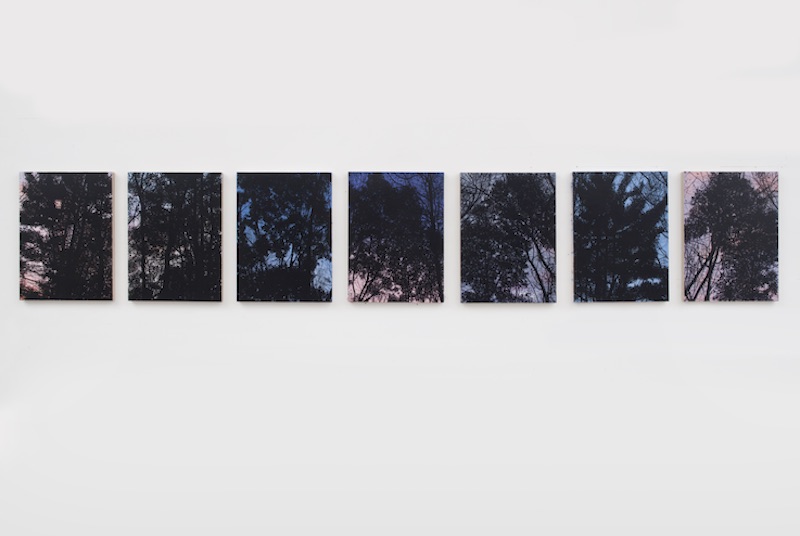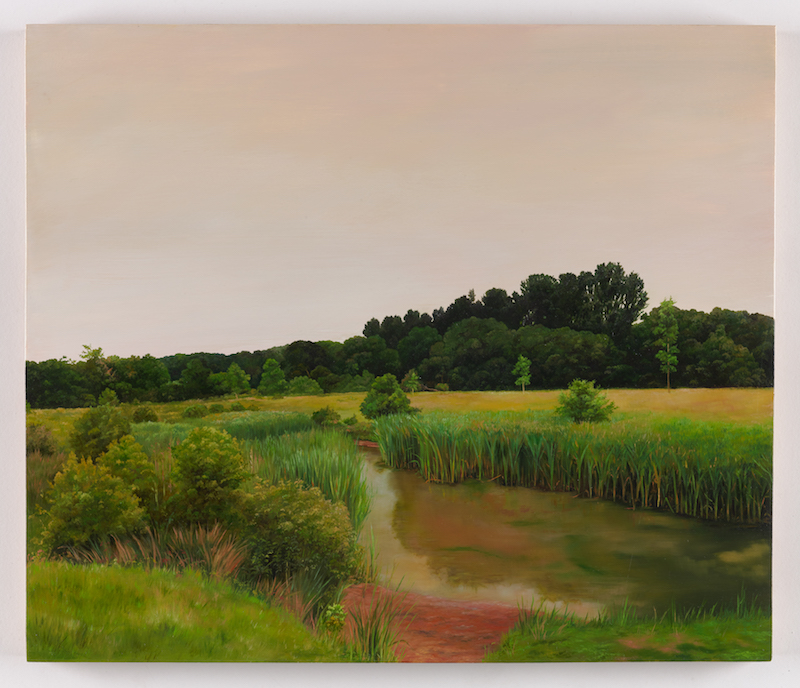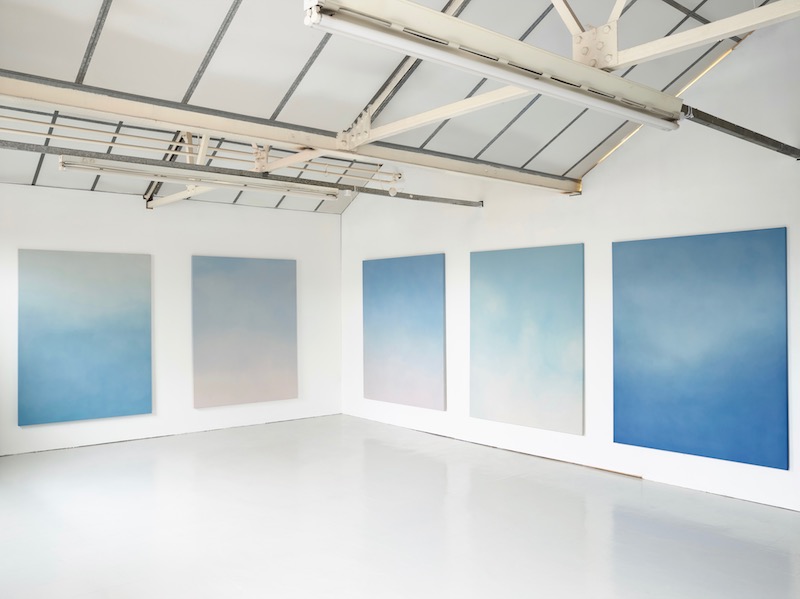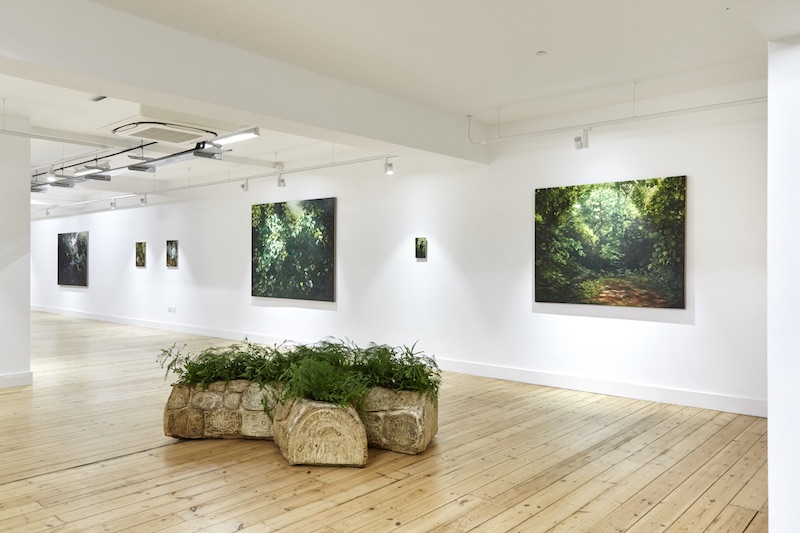June 05, 2020
As part of a growing number of artists who are addressing landscape through the traditional medium of painting, we invited Hannah Brown and Rebecca Partridge to have a conversation, which took place over Zoom from their respective London studios. The pair met in 2019 when Partridge invited Brown to contribute to an exhibition at Arthouse1, London: the most recent in a series of exhibitions she has curated over the past ten years in Germany, Norway and the UK, considering the role of landscape in contemporary practice. Here, they discuss their mutual interests in our human relationship to the natural environment, what it means to experience a landscape, the weighted history of landscape painting and making work during lockdown.

Hannah Brown: ‘Hedge 4,’ 2018, oil on linen, 150 x 200 cm // Photo credit Anna Arca
Rebecca Partridge: There has been a marked resurgence of interest in landscape painting recently, reflected not only in what is being exhibited, but in survey books such as ‘Landscape Painting Now.’ What do you think it means to paint a landscape as a contemporary artist?
Hannah Brown: That’s a good question. For me, it means that landscape is still a relevant subject. I remember 15 years ago, while I was a student, being told by a visiting tutor that “landscape is done.” I was shocked. Although it has a weighted history, which can make it a difficult genre to work within, the land carries on changing and our relationship to it is as pertinent as ever. I feel there is a role for the artist to respond to this.
RP: It is interesting how both of us have come to it from a different background; you were making sculptures, I was making abstract paintings yet at a similar time we turned to landscape, which, at least for me, seemed like the natural platform to think about current issues.
HB: Absolutely. Until my MA I was making text-based installations and sculptures. I wrote lists and drew diagrams about how I felt at the time and observations on British society. I slowly started including photographs in my work and these evolved into paintings. I found, through image-making, I could have a better conversation about the world around me. At this time, artists like George Shaw were getting recognition, which paved the way for painting landscape.

Rebecca Partridge: ‘Week,’ 2017, heptaptych, watercolour, ink and tempera on birch ply panel, each 40 x 30cm // Photo credit Ludgar Paffrath
RP: George Shaw is an interesting example because although he reopened the genre it still relied on an element of subversion; scenes of romantic decay in run-down, overlooked parts of working class Britain, painted with hobby paint. Other painters at that time used distancing strategies as a way to approach romantic subject matter, for instance by reproducing digital images of landscapes found on the internet—places they had never actually experienced. Whereas to you and I, and many of our contemporaries, it’s vital to actually have been there, to have had the experience of being in landscape, which 15 years ago would have seemed absurdly sentimental.
HB: I can’t imagine painting a view that I haven’t seen first-hand. I just wouldn’t have a connection with it. I have to have been there and taken the photograph to want to paint it. I remember you saying that it was like a love affair with the place or object you are painting and I couldn’t agree more. I guess we are fortunate that there is a credible place for representational painting today, without the disguise of irony or subversion to validate it.
RP: How important do you think the experience of looking is in this? I have somehow bracketed off the weight of art historical and theoretical problems of the medium by returning to the idea of intention, and paying attention to the environment, painting being the ideal way of embodying that sustained looking through its duration and our visual empathic responses to reading the physical process. In a time of climate crisis and environmental fragility, I feel it’s more important than ever that we pay that kind of attention and care.
HB: I think it’s crucial. Both for the artist and the viewer. When I choose a view to paint I often think of Baldessari’s ‘Commissioned Paintings.’ I imagine a big finger pointing and saying “look at this.” I’m sharing an image of something I think is worth giving time to. By painting a view, I really give it consideration and I hope that some of this translates to the viewer.

Hannah Brown: ‘The field next to Tesco that is soon to be built on – 4,’ 2017, oil on marine plywood and oak, 40 x 47cm // Photo credit Anna Arca
RP: The landscapes that you point us to vary between non-locatable landscapes such as the ‘Hedge’ series, which feel more psychological, and others that are quite specific. In ‘The field next to Tesco that is soon to be built on’ you are introducing a narrative about land use and asking us to consider the future of that landscape. The title imbues them with a sense of nostalgia and imminent loss.
HB: When I started working on the Tesco paintings, in my head they were “the field next to Tesco that is soon to be built on” because that is what it was. When I finished the series, I kept the title because I wanted to give context to the view and acknowledge the imminent change. I had started sketching the area the year before and was unsure if I would paint it because it’s actually not that attractive, it’s just scrubland on the outskirts of a town. When I found out it was going to be built on, I became more sentimental about the place and it now it reads like a beautiful landscape that was lost. But that only comes from the title. As with yours, they are factual describers.

Rebecca Partridge: ‘Sky Studies,’ 2019 // Photo credit Peter Mallett
RP: That’s interesting. For me the titles are descriptors because I don’t want to suggest a narrative that would get in the way of the viewers perceptual experience of the painting. Equally, I am tied to being objective—I don’t edit or manipulate what I see. Okay, I am selecting the sky, or that part of the canopy, but I am just showing you what’s there and you can’t argue with that. That said, the ‘Sky Studies’ come from memory, so it’s a strange relationship to objectivity, but the memory can only happen when I have had a sustained experience of looking to begin with. I find in those works I get closer to a feeling of bodily connection to the landscape because memory enables a kind of physicality in the making. That longing for physical connection with landscape feels all the more resonant in the current situation.
HB: Yes, it feels like people are rediscovering a connection with nature in lockdown. There is comfort in the natural world remaining stable in comparison to the huge social changes we have experienced in such a short space of time.
RP: Do you think the questions that come out of painting a landscape, of articulating something of our relationship to the natural environment, feel more important than ever?
HB: I think it goes back to the first question of what does it mean to paint a landscape, which feels more relevant this month than it did four months ago. I think our desire for landscape, our use of it, and our relationship to it has been heightened. Due to the pandemic, I feel a renewed sense of purpose and perhaps with this comes meaning.
This article is a part of our Features’ topic ‘Landscape’. The themes in this topic are inspired by the exhibition ‘The White, the Green, and the Dark: Contemporary Positions from Norway,’ presented by the Royal Norwegian Embassy in Berlin, and aim to spark a dialogue with its curatorial framework. The exhibition explores concepts of identity and home through intimate portrayals of the region’s landscape, both ecological and social, using a wide variety of media from sound and film to textile and sculptural works. A further emphasis of the contemporary works on display is the presentation of works by artists who belong to the Indigenous ethnic group of the Sámi. To read more from this topic, click here.
Artist Info
rebeccapartridge.com
hannahbrown.info
Exhibition Info
BROADWAY GALLERY
Hannah Brown & Christopher Orr: ‘This Muddy Eden’
Exhibition: Feb. 28–July 31, 2020
2, The Arcade, Letchworth Garden City SG6 3EW, UK, click here for map
HESTERCOMBE GALLERY
Rebecca Partridge, Group Show: ‘Most Admirably Improved by Art’
Exhibition: Mar. 01–June 28, 2020
Hestercombe, Taunton TA2 8LG, UK, click here for map

Installation view ‘This Muddy Eden: Hannah Brown and Christopher Orr,’ Broadway Gallery, Letchworth, U.K, 2020 // Photo courtesy of the gallery
























